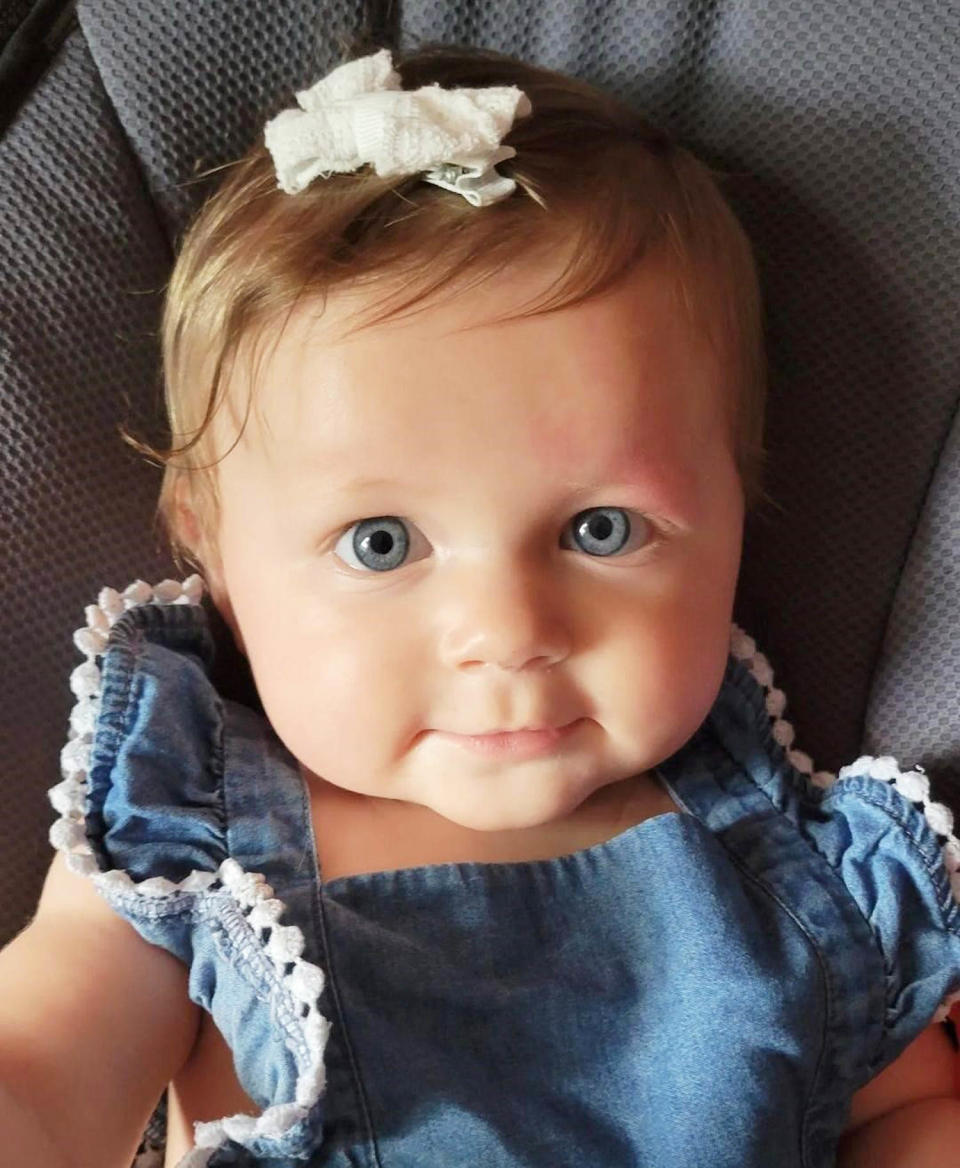Mom noticed birthmark above her daughter's eye. It was sign of seizure-causing condition
When Danielle Gourdeau first gazed at newborn Jasmine on October 1, 2021, she noticed a spot on her daughter’s eye. At first, she didn’t worry about it.

“They thought that maybe the mark about her eye could have been a bruise due to the traumatic birth,” Gourdeau, 36, of Massachusetts, tells TODAY.com. “My first child, my son, was also a traumatic birth and he had some markings on his face.” But the spot didn’t go away and Gourdeau realized it was a birthmark. When she mentioned it to Jasmine’s pediatrician at her first visit, the doctor suggested something unexpected — that Jasmine might have something called Sturge-Weber syndrome, a condition that can lead to seizures, migraines and other neurological troubles.
“I had never heard of it,” Gourdeau says. “I was undoubtedly terrified. I wanted to know if this was something that was genetically connected to me, like I gave it to her … and then get her treated as soon as possible.”
When a birthmark is a sign of something else
Before that visit to the doctor, Gourdeau thought little of the raised blush colored mark above Jasmine’s left eye. A home-visiting nurse said that it was likely a birthmark, which encouraged Gourdeau to mention it to Jasmine’s doctor. She was surprised when the doctor recommended she take Jasmine to the Surge-Weber Syndrome Clinic at Boston Children’s Hospital.
"I just wanted to know if there was something wrong and if she needed to be treated,” Gourdeau says.
When Jasmine went to the clinic she met director, Dr. Anna Pinto, who recommended than Jasmine undergo an MRI. The results confirmed what the doctors suspected — Jasmine had Sturge-Weber syndrome, a rare neurological condition accompanied by a port wine birthmark and seizures.
“Everything I (read about the syndrome) absolutely terrified me,” Gourdeau says.
The clinic offers treatments to address the aesthetic appearance of the birthmark, but Gourdeau was more concerned about the impact the condition would have on her daughter’s brain.
“(Dr. Pinto said) usually within the first year of life, we see seizures,” Gourdeau recalls. “I faded out. I didn’t really absorb what she was saying. I must have asked her to repeat herself two or three times.”
After Gourdeau's shock wore off, Pinto explained that doctors can treat Sturge Weber syndrome with an anti-seizure medication and aspirin. Pinto — who participated in a retrospective study of this protocol — saw that this medication regimen could lessen or even stop babies with Sturge Weber from having seizures.
“The seizures themselves could possibly lead to irreparable damage to her brain,” Gourdeau says. “So why not avoid them?”

After much thought, Gourdeau agreed to the treatment.
“It was scary being in the position that I was in, (wondering) am I making the right choice?” she says.
Sturge Weber syndrome
Having a birthmark doesn’t necessarily indicate a health problem. But when babies have port wine birthmarks “located on the upper eyelid, in the forehead,” it could be a sign of Sturge Weber syndrome, Pinto says. Those who have the condition develop too many capillaries in the skin and also have “abnormal blood vessels on the brain’s surface,” the National Institute of Neurological Disorders and Stroke says.
A port wine birthmark on the brow and forehead “increases the chances of having the same vascular malformation inside the brain, in the area surrounding the brain tissue — and this can lead to neurological symptoms (with) seizures being the most common,” Pinto, an attending physician in the department of neurology, division of epilepsy at Boston Children’s Hospital, tells TODAY.com. Children with these birthmarks “should be seen by a neurologist.”
Children with Sturge Weber syndrome often develop seizures and migraines, she notes. But symptoms can appear later.
“Some cases can be asymptomatic (for) a period of time,” she says. “We have very mild cases, or they have late onset neurological symptoms. There’s a large variation.”
For some children, early onset seizures can be devastating for their development, she says. To address that, children who have EEG or MRI results that indicate “vascular abnormalities” in the brain are treated with an anti-seizure medication and aspirin.
“What we have found is that by giving a seizure medication associated with aspirin before the seizures (begin) can decrease the amount of seizures,” Pinto explains. “It can delay the onset as well as decrease the magnitude of the epilepsy.”
Right now, it seems as if that they might not have to continue the medication throughout their lives, she says. But there are some variables.
“If the patient does not develop any symptoms when we repeat the MRI, if there is no progression of the disease (and) the brain is safe, we can offer to stop the treatment,” she says. “However, (with) some of the patients what happened is that we delayed the onset of the neurological symptoms, and they still can develop seizures.”
Pinto says there is a multi-center study examining the natural history of Sturge Weber syndrome so experts gain a better understanding of how the disease manifests across the population. Experts know that it can range from mild to severe and that it doesn’t seem to contribute to increase mortality, she notes. But some people with it experienced a diminished quality of life, many with severe or frequent seizures being unable to drive, for example.
Many who have epilepsy as a result of Sturge Weber take medication that impacts their memories and many also have ADHD, Pinto says. “This condition is highly associated with depression (and) anxiety," she adds.
Raising awareness
Jasmine, now almost 3, is still taking the medications and Gourdeau believes the intervention had a tremendous impact on her daughter.
“They have saved my daughter, I truly believe, from having to suffer from any seizures,” she says. “The odds were stacked against her, and she has surpassed them.”
Every year, Jasmine undergoes an MRI and when she’s 4 the doctors might re-evaluate her medications, either reducing or eliminating what she takes.
“Hopefully at her 4th birthday her MRI will show no signs of any damage, any seizure activity,” Gourdeau says.

Jasmine experienced some developmental delays where she was slow to hold up her head, sit and crawl. But she participated in early interventions, such as physical, speech and occupational therapy, and is doing well now.
“Every transition has been a little bit different and a little more difficult or a little bit (scary),” Gourdeau says. “In hindsight of it all, I would not have changed what I had done. (Boston Children's Hospital) absolutely made sure that she was going to be OK.”
Today, Jasmine is “hitting milestones,” and enjoying life. She loves music, dancing and running around the park.
“She’s very rambunctious,” Gourdeau says. “Nothing stops her. She’s spicy.”
When Jasmine angers, her birthmark becomes a darker red, a telltale sign for Gourdeau to be cautious. But her fury is fleeting.
“She’s very, very happy,” she says.
Gourdeau hopes that others learn from Jasmine’s story. If a child has a port wine birthmark above the eye or in the forehead, they should visit a doctor.
“Stick to your motherly instincts, stick to your fatherly instincts,” she says. “If you think there may be something wrong, don’t overthink it … (take) action.”
This article was originally published on TODAY.com

